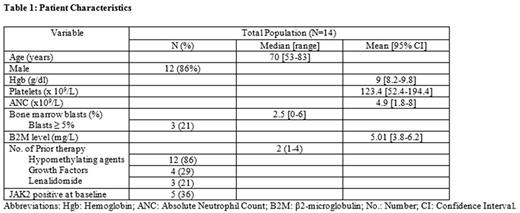Abstract

Background:Prognosis of lower risk MDS pts who failed one line of therapy is heterogeneous. Median overall survival (OS) of lower risk MDS pts who failed hypomethylating agents (HMAs) is about 17 months. Several studies have indicated that deregulation of pathways involved in innate immunity signaling is frequent in lower risk MDS. This process involves Toll-like receptor activation, cytokine overexpression, and NF-kB activation which parallels activation of the JAK-STAT system. We hypothesized that ruxolitinib, a JAK2 inhibitor, could have activity in a subset of lower risk MDS pts.
Methods: We designed a pilot phase I trial of dose escalation of ruxolitinib for pts with previously treated MDS classified as Low or Intermediate-1 by the International Prognostic Scoring System (IPSS) and signs of JAK-STAT activation determined by either: elevated β2-microglobulin (B2M) levels x2 upper limit of normal, presence of a JAK2 mutation, or presence of phosphorylated p65 (pp65) NF-κB component in at least 5% of bone marrow (BM) cells. Sequencing data was obtained at the time of pre-treatment evaluation by the use of a 28-gene next generation sequencing platform. The primary objective was to determine the maximum tolerated dose (MTD) and dose limiting toxicity (DLT) of ruxolitinib. The secondary objective was to determine the clinical and molecular activity of ruxolitinib. Responses were based on the 2006 International Working Group criteria. Pts were assigned to 4 dose levels [ruxolitinib 5, 10, 15, and 20 mg administered orally twice daily (BID) on a 28 day cycle] using a 3+3 dose-escalation design to determine the MTD. DLTs were evaluated during the first two cycles of therapy. After completion of the first dose level, pts at subsequent dose levels received the prior dose level for 1 month with dose escalation on the second month (e.g. in dose level 2, pts received 5 mg in cycle 1 and 10 mg in cycle 2).
Results: Fourteen pts have been enrolled so far (4 CMML, 10 MDS); 3 pts (21 %) classified as low-risk and 11 (79 %) as intermediate-1-risk by IPSS. All pts were evaluable for toxicity and response. Patient characteristic are shown in Table 1. Median age was 70 years (range, 53-83). Ten pts had diploid cytogenetics (71%) and 4 pts had intermediate karyotype. Sequencing data was available in 10 (71%) pts. Inclusion criteria included elevated B2M in 2 (14%) pts, phosphorylated p65 in 9 (64%), and presence of JAK2 mutation in 3 (21%). Among pts with detectable bone marrow pp65, mean pp65 positivity was 28% (14-42%). Additional mutations were detected in 4 pts including NRAS (N=2), TP53 (N=1), and one pt had ASXL1, KRAS, and TET2 mutations. Median number of cycles of ruxolitinib was 3 (range, 2-14). There were no dose reductions with only one pt requiring treatment interruption. No DLT was observed and the MTD was ruxolitinib 20 mg BID. Grade 3-4 toxicities occurred in 11 pts (79%) with the most common being thrombocytopenia (N=5, 36%) and anemia (N=7, 50%). The overall response rate was 21% (3/14), with 2 pts achieving hematological improvement in platelets (HI-P) and 1 pt achieving partial cytogenetic response. Median time to response was 8 weeks (range 4-8 weeks). Among pts with detectable pp65 at the time of initial evaluation, a trend to reduced pp65 expression after therapy was observed, with a mean pp65 expression after therapy of 26% (12-39%, p=0.81). Median follow up was 8.5 months (range 2-24 months) with median OS not having been reached at the current time of follow up. A total of 5 (36%) pts remain on study and have received a median of 4 cycles (range 2-14); 4 have no response (NR) so far and 1 achieved HI-P. Among responders, 2 pts had progression of disease (response duration was 1 and 4 months, respectively) and 1 remains in HI-P after 11 months of follow up. A total of 2 (14%) pts were taken of study due to progression (including transformation to AML in one patient), 5 (36%) due to absence of response, 1 (7%) to proceed to allogeneic stem-cell transplantation (SCT) and 1 (7%) due to development of a second malignancy. Two pts received SCT; 1 had NR to ruxolitinib after 2 cycles and the other transformed to AML, both alive post-SCT. Three pts (21 %) died; 2 due to AML progression and 1 from unrelated stroke complications.
Conclusion:Ruxolitinib is well tolerated and active in lower-risk MDS pts with cytokine dysregulation. Although correlative studies show a trend towards reduction in pp65 expression, this did not correlate with response to ruxolitinib.
Jabbour:ARIAD: Consultancy, Research Funding; Pfizer: Consultancy, Research Funding; Novartis: Research Funding; BMS: Consultancy. Daver:Kiromic: Research Funding; Ariad: Research Funding; Pfizer: Consultancy, Research Funding; Sunesis: Consultancy, Research Funding; Karyopharm: Honoraria, Research Funding; BMS: Research Funding; Otsuka: Consultancy, Honoraria. DiNardo:Agios: Other: advisory board, Research Funding; Celgene: Research Funding; Abbvie: Research Funding; Daiichi Sankyo: Other: advisory board, Research Funding; Novartis: Other: advisory board, Research Funding.
Author notes
Asterisk with author names denotes non-ASH members.

This icon denotes a clinically relevant abstract


This feature is available to Subscribers Only
Sign In or Create an Account Close Modal